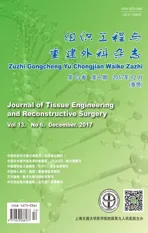皮肤γδT细胞在维持上皮完整和伤口愈合中的作用
2017-01-11王配合何泽亮李晓东安亮恩卓勤强刘玲玲
王配合 何泽亮 李晓东 安亮恩 卓勤强 刘玲玲
皮肤γδT细胞在维持上皮完整和伤口愈合中的作用
王配合 何泽亮 李晓东 安亮恩 卓勤强 刘玲玲
研究证实小鼠皮肤树突状表皮 γδT 细胞(Dendritic epidermal γδ T cells,DETCs)表达的 γδTCR,由 Vγ3Jγ1-Cγ1和Vδ1Dδ2Jδ2-Cδ链组成,特异性表达于成年小鼠皮肤中。DETCs活化后分泌多种细胞因子、生长因子、趋化因子等,这些因子与组织修复,以及细胞存活、增殖、迁移和募集有关,在维持上皮组织完整性和上皮组织修复中发挥关键作用。本文就DETCs在维持上皮组织的完整和组织修复过程中的作用进行综述。
γδT细胞 上皮完整 组织修复 皮肤
胸腺及外周淋巴组织中的成熟T细胞,其受体 (T-cell antigen receptor,TCR)主要为 αβTCR,小部分为 γδTCR。习惯上把这两种T细胞分别称为αβT细胞和γδT细胞。Asarnow等[1]研究证实,小鼠皮肤树突状表皮γδT细胞(Dendritic epidermal γδ T cells,DETCs)表达的 γδTCR,由 Vγ3Jγ1-Cγ1 和Vδ1Dδ2Jδ2-Cδ链组成,特异性表达于成年小鼠皮肤中。DETCs活化后分泌多种细胞因子、生长因子、趋化因子等,包括角质化细胞生长因子-1(Keratinocyte growth factor-1,KGF-1)、角质化细胞生长因子-2(Keratinocyte growth factor-2,KGF-2)[2]、胰岛素样生长因子-1(Insulin-like growth factor-1,IGF-1)[3]、白介素-2(Interleukin-2,IL-2)、干扰素-γ(Interferon-γ,IFN-γ)[4]和淋巴细胞趋化因子等。这些因子参与组织修复,以及细胞存活、增殖、迁移和募集等,并在维持上皮组织完整性和创面修复中发挥关键作用。本文就DETCs在维持上皮组织的完整和组织修复过程中的作用进行综述。
DETCs起源于早期胎儿胸腺前体细胞,在发育过程中,从胸腺移行到皮肤[5]。皮肤DETCs在创伤修复方面的重要作用的发现,是源于DETCs缺陷小鼠与野生型小鼠相比,伤口闭合时间延迟[6]。体外组织器官培养研究中也发现类似现象,DETCs缺陷时组织修复延迟,但补充DETCs后创面修复缺陷可得到纠正。因此,DETCs可能参与维持上皮组织完整性和创面修复的过程。表皮的损伤修复涉及一系列复杂的调节过程,DETCs可能在炎症反应、角质化细胞增殖、细胞外基质沉积和重塑等多个过程中发挥作用。
1 DETCs可维持角质化细胞的存活并促进增殖
表皮是机体重要的生理屏障,其90%由角质化细胞组成。当机体受伤时,角质化细胞迅速增殖使伤口愈合,恢复表皮的完整性[7]。DETCs缺失时,角质化细胞的功能和组织修复就会受到损害[3],提示DETCs可能通过某种途径在创伤修复中发挥作用。树突状的DETCs同时与很多不同的角质化细胞连接,可被处于应激状态、损伤或变形的角质化细胞激活[8-10]。同时,DETCs活化后分泌的细胞因子又参与维持角质化细胞的存活和增殖[11]。研究发现,与野生型鼠相比,DETCs缺陷的鼠发生角质化细胞凋亡的数量增加,说明DETCs能抑制角质化细胞的凋亡,参与角质化细胞稳态的调节[11]。将角质化细胞和活化的DETCs共培养,发现DETCs也可在角质化细胞增殖中发挥作用[12]。伤后3~5 d,TCRδ-/-小鼠较野生型小鼠角质化细胞增殖速度显著减慢,虽然TCRδ-/-小鼠存在早期角质化细胞增殖受阻的现象,但创面最终愈合,说明DETCs可能通过影响角质化细胞的增殖速度发挥作用[13-14]。
2 DETC分泌的细胞因子
2.1 IGF-1
DETCs激活后,构成性表达胰岛素样生长因子-1。IGF-1与受体结合后可调节细胞的大小、增殖和凋亡。研究发现,过表达IGF-1的小鼠表皮增厚[15],而缺乏IGF-1的鼠表皮则显得菲薄[16-17],说明IGF-1与角质化细胞的增殖和稳态的维持有关。这可能与IGF-1和IGF-1R结合后通过PI3K、MAPK途径参与细胞生存的调节有关。DETC在激活及静息状态均可分泌IGF-1,表明IGF-1可能同时参与了表皮稳态的维持。IGF-1还可抑制地塞米松诱导的皮肤DETCs凋亡[11]。表皮中的IGF-1主要由皮肤DETCs分泌,而角质化细胞不分泌。但DETCs和角质化细胞均表达IGF-1R,而IGF-1R信号可抑制角质化细胞分化和凋亡[17]。因此,DETCs分泌的IGF-1可能通过自分泌和旁分泌两种途径参与表皮稳态的维持。
2.2 KGF
除了构成性分泌IGF-1,活化的DETCs还可分泌KGF-1(FGF-7)和 KGF-2[2,6]。 皮肤受到创伤后可诱导 KGF-1 产生,应用KGF-1和KGF-2可提高创面愈合效率,而KGF受体表达缺陷可导致小鼠创伤愈合障碍,说明其在创面愈合中发挥重要作用[18-19]。KGF-1和KGF-2可刺激角质化细胞增殖,而使用KGF拮抗剂可阻断DETCs诱导的角质化细胞增殖,说明KGF在参与DETCs诱导角质化细胞中具有重要作用[12]。KGF-1和KGF-2可能通过与角质化细胞表达的FGFR-2Ⅲb受体结合诱导角质化细胞增殖[20]。
活化的DETCs都能分泌KGF-1和KGF-2,在KGF-1缺陷鼠中,没有明显的皮肤创伤愈合缺陷,提示KGF-1和KGF-2在促进角质化细胞增殖和皮肤创伤愈合中可以相互替代[6]。野生型小鼠伤口附近的角质化细胞增殖,而TCRδ-/-小鼠中则没有这种现象[6]。上皮中特异的生长因子KGF-1和KGF-2只由上皮DETCs分泌,说明DETCs可能在组织损伤修复中发挥作用。
2.3 其他细胞因子
此外,活化的DETCs还分泌IL-2、IL-3、粒细胞-巨噬细胞集落刺激因子、IFN-γ和TNF-α[4,21]。 这些细胞因子可以调节DETCs自身和角质化细胞及其他相邻细胞的活化和功能。角质化细胞和朗格汉斯细胞同时又是很多细胞因子的起源,可以分泌包括IL-7和IL-15等多种因子参与细胞代谢。研究表明,IL-7和IL-15也参与了DETCs的稳态、发育和成熟过程的调控,且DETCs在皮肤中的定位信号通路需要IL-15的介导[22-23]。在维护皮肤稳态和创伤修复过程中,细胞因子是DETCs、角质化细胞、朗格汉斯细胞和其他上皮细胞相互作用的一个重要组成部分[24-25]。
3 趋化因子
趋化因子是保证细胞间相互作用的另外一群分子。局部分泌的趋化因子在皮肤炎症和外伤时,可指示细胞迁移和聚集到适当部位发挥作用。DETCs识别损伤的上皮后局部活化,分泌趋化因子,从而参与其他对损伤部位具有特定功能细胞的募集[24]。已经发现活化的DETCs可以表达淋巴细胞趋化因子、 巨噬细胞炎性蛋白-1α (MIP-1α)、MIP-1β 和RANTES[26]。DETCs分泌的淋巴细胞趋化因子引导CD8+αβT细胞的趋化性,表明DETCs在皮肤损伤或疾病后引起的炎症过程中发挥功能,进而干预上皮完整和伤口愈合过程[26]。相反,在DETCs表达缺陷时,αβT细胞浸润至损伤表皮的过程则会延迟[27]。另外,有研究表明,DETCs也可参与调节炎症细胞浸润表皮的过程[28]。DETCs诱导趋化因子是其在保持或修复表皮完整性过程中的一条重要途径[14,29]。
4 DETCs参与炎症反应和基质沉积
炎性细胞是创伤修复过程的主要参与者。浸润细胞的类型和持续时间是创伤愈合的关键。DETCs缺陷的小鼠,创面中性粒细胞浸润正常,而巨噬细胞浸润迁移延迟[28]。TCRδ-/-小鼠与正常小鼠相比,大量巨噬细胞出现在皮下组织,说明巨噬细胞从血液中外渗可能不存在缺陷,但其迁移存在障碍。
在创伤部位透明质酸沉积增多[23],但DETCs缺陷的小鼠的创面分泌透明质酸延迟[25]。TCRδ-/-小鼠透明质酸沉积缺陷现象,可能是由于从DETCs到角质化细胞缺乏HAS诱导的关键信号。角质化细胞与DETCs共培养,活化的DETCs诱导透明质酸合成,而加入FGFR2-Ⅲb封闭肽 (竞争与KGF-1和KGF-2的结合)则使透明质酸合成降至基线水平[30]。这个结果证明DETCs分泌的KGFs可诱导角质化细胞合成透明质酸。此外,研究还发现,将KGF-1、透明质酸或缓冲液加入损伤部位,透明质酸和KGF-1能修复巨噬细胞浸润缺陷[27],说明可能由于TCRδ-/-小鼠皮肤中透明质酸水平降低,从而使巨噬细胞浸润延迟。DETCs可能通过参与炎症反应和调节基质沉积在维护皮肤稳态和创伤修复过程中发挥作用。
5 小结
皮肤DETCs参与表皮多个方面的调节,通过分泌IGF-1参与调节角质化细胞的存活。当皮肤稳态受到损伤时,DETCs通过分泌KGF促进角质化细胞增殖;通过诱导透明胶质酸分泌,诱导巨噬细胞浸润。其他组织的DETCs,例如肺和肠道,在表皮维护方面显示出相似的作用。DETCs存在于所有哺乳动物的上皮,表明在保护组织完整性方面发挥保守作用。上皮稳态的破坏可能阻碍正常修复机制,导致创面不愈合、感染或恶性肿瘤发生。因此,临床上亟需针对慢性创伤的治疗新策略,而DETCs可能在这方面可以发挥巨大作用。
[1] Asarnow DM,Kuziel WA,Bonyhadi M,et al.Limited diversity of γδ antigen receptor genes of Thy-1+dendritic epidermal cells[J].Cell,1988,55(5):837-847.
[2] Boismenu R,Havran WL.Modulation of epithelial cell growth by intraepithelial γδ T cells[J].Science,1994,266(5188):1253-1255.
[3] Sharp LL,Jameson JM,Cauvi G,et al.Dendritic epidermal T cells regulate skin homeostasis through local production of insulin-like growth factor 1[J].Nat Immunol,2005,6(1):73-79.
[4] Boismenu R,Hobbs MV,Boullier S,et al.Molecular and cellular biology of dendritic epidermal T cells[J].Semin Immunol,1996,8(6):323-331.
[5] Havran WL,Allison JP.Origin of Thy-1+dendritic epidermal cells of adult mice from fetal thymic precursors[J].Nature,1990,344(6261):68-70.
[6] Jameson J.A role for skin γδ T cells in wound repair[J].Science,2002,296(5568):747-749.
[7] Madison KC.Barrier function of the skin:"la raison d'être"of the epidermis[J].J Invest Dermatol,2003,121(2):231-241.
[8] Lewis JM,Tigelaar RE.Recognition of an epidermal stress antigen by murine γδ dendritic epidermal T cells(DETC)[J].J Invest Dermatol,1991,96:538A.
[9] Reardon CL.Murine epidermal Vγ5/Vδ1-T-cell receptort+T cells respond to B-cell lines and lipopolysaccharides[J].J Invest Dermatol,1995,105(1 suppl):58S-61S.
[10] Whang MI,Guerra N,Raulet DH.Costimulation of dendritic epidermal γδ T cells by a new NKG2D ligand expressed specifically in the skin[J].J Immunol,2009,182(8):4557-4564.
[11] Ramirez K,Witherden DA,Havran WL.All hands on DE(T)C:Epithelial-resident γδ T cells respond to tissue injury[J].Cell immunol,2015,296(1):57-61.
[12] Han DS.Keratinocyte growth factor-2(FGF-10)promotes healing of experimental small intestinal ulceration in rats[J].Am J Physiol Gastrointest Liver Physiol,2000,279(5):G1011-G1022.
[13] Jameson J,Havran WL.Skin γδ T‐cell functions in homeostasis and wound healing[J].Immunol Rev,2007,215(1):114-122.
[14] Girardi M,Lewis JM,Filler RB,et al.Environmentally responsive and reversible regulation of epidermal barrier function by γδ T cells[J].J Invest Dermatol,2006,126(4):808-814.
[15] Bol DK,Kiguchi K,Gimenez-Conti I,et al.Overexpression of insulin-like growth factor-1 induceshyperplasia,dermal abnormalities,and spontaneous tumor formation in transgenic mice[J].Oncogene,1997,14(14):1725-1734.
[16] Liu JP,Baker J,Perkins AS,et al.Mice carrying null mutations of the genes encoding insulin-like growth factor I(Igf-1)and type 1 IGF receptor(Igf1r)[J].Cell,1993,75(1):59-72.
[17] Sadagurski M.Insulin-like growth factor 1 receptor signaling regul atesskin developmentand inhibitsskin keratinocyte differentiation[J].Mol Cell Biol,2006,26(7):2675-2687.
[18] Werner S,Peters KG,Longaker MT,et al.Large induction of keratinocyte growth factor expression in the dermis during wound healing[J].Proc Natl Acad Sci USA,1992,89(15):6896-6900.
[19] Werner S.The function of KGF in morphogenesis of epithelium and reepithelialization of wounds[J].Science,1994,266(5186):819-822.
[20] Johnson DE,Williams LT.Structural and functional diversity in the FGF receptor multigene family[J].Adv Cancer Res,1993,60:1-41.
[21] Yoshida S,Mohamed RH,Kajikawa M,et al.Involvement of an NKG2D ligand H60c in epidermal dendritic T cell-mediated wound repair[J].J Immunol,2012,188(8):3972-3979.
[22] Baccala R.γδ T cell homeostasis is controlled by IL-7 and IL-15 together with subset-specific factors[J].J Immunol,2005,174(8):4606-4612.
[23] Lewis JM,Girardi M,Roberts SJ,et al.Selection of the cutaneous intraepithelial γδ + T cell repertoire by a thymic stromal determinant[J].Nat Immunol,2006,7(8):843-850.
[24] MacLeod AS,Havran WL.Functions of skin-resident γδ T cells[J].Cell Mol Life Sci,2011,68(14):2399-2408.
[25] Toulon A,Breton L,Taylor KR,et al.A role for human skinresident T cells in wound healing[J].J Exp Med,2009,206(4):743-750.
[26] Boismenu R,Feng L,Xia YY,et al.Chemokine expression by intraepithelial γδ T cells:implications for the recruitment of inflammatory cells to damaged epithelia[J].J Immunol,1996,157(3):985-992.
[27] Jameson JM,Cauvi G,Sharp LL,et al.γδT cell-induced hyaluronan production by epithelial cells regulates inflammation[J].J Exp Med,2005,201(8):1269-1279.
[28] Tagashira S,Harada H,Katsumata T,et al.Cloning of mouse FGF10 and up-regulation of its gene expression during wound healing[J].Gene,1997,197(1-2):399-404.
[29] Girardi M.Resident skin-specific γδT cells provide local,nonredundant regulation of cutaneous inflammation[J].J Exp Med,2002,195(7):855-867.
[30] Manuskiatti W,Maibach HI.Hyaluronic acid and skin:wound healing and aging[J].Int J Dermatol,1996,35(8):539-544.
Skin γδT-Cell Functions in Epithelium Integrity and Wound Healing
WANG Peihe,HE Zeliang,LI Xiaodong,AN Liang'en,ZHUO Qinqiang,LIU Lingling.Department of Burns and Plastic Surgery,Bethune International Peace Hospital of PLA,Shijiazhuang 050082,China.
【Summary】The research showed that the dendritic epidermal γδ T cells (DETCs)found in murine skin expressed a γδTCR composed of Vγ3Jγ1-Cγ1and Vδ1Dδ2Jδ2-Cδ chains which specifically expressed in murine skin.Activated DETCs produce several cytokines,growth factors and chemokines.All these factors were related to tissue repair,cell survival,proliferation,migration,recruitment,and play a key role in maintaining the epithelium integrity and repairing the epithelial tissue.In this paper,the functions of DETCs in maintaining the epithelium integrity and would repair were reviewed.
γδT cell;Epithelium integrity;Tissue repair; Skin
R329.2+8
B
1673-0364(2017)06-0354-03
10.3969/j.issn.1673-0364.2017.06.015
050082 河北省石家庄市 中国人民解放军白求恩国际和平医院烧伤整形科。
2017年9月21日;
2017年11月4日)
